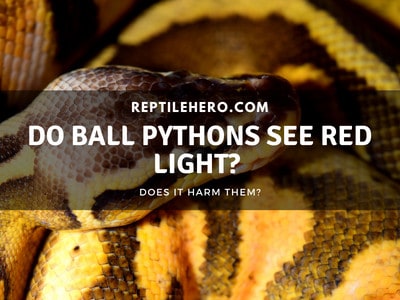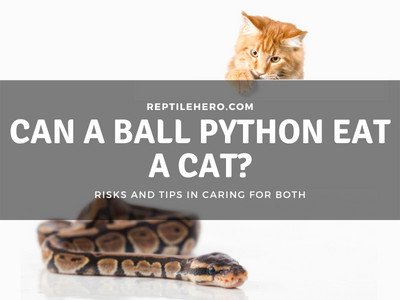Are Ball Pythons Blind? Kind Of
Are you curious as to what your ball python can see? Wondering whether or not they’re blind? A ball python’s sight is important for hunting and exploration, which means eye problems can affect its way of life.
Ball pythons are not blind. However, they have poor eyesight, especially during the daytime. To compensate for their poor vision, ball pythons can sense infrared radiation allowing them to “see” in the dark.
A snake’s vision is often depicted as a heat signature in mainstream media. But is this really true? How well do ball pythons see? What are signs that they have eye problems? Find out the answers to these questions as you read until the end!
How Well Can Ball Pythons See?
Ball pythons have poor eyesight and cannot see objects several feet away clearly. They are also see fewer colors, mainly blue and green, in comparison to humans.
A ball python can see what is in front of them. So If you go near the ball python—more or less a foot—it can see you clearly through its eyes.
However, if you stand 2 or more feet away, there is a high chance that you will look like a big blurry object in your python’s eyes.
I also observe this with my ball python, Choco. He reacts fearfully when he sees me moving from about 3–4 feet away. But he will calm down once I come closer. This means he recognizes me clearly at short distances.
Ball pythons, like most snakes, are only colorblind to the color red. They have a dichromatic vision which means that they can only see 2 colors, namely, green and blue.

Even though ball pythons can’t see red the same way we can, they can still see the light emitted by a red lamp. So I do not recommend using any kind of light during the night even if it’s a red “night light” because it can still disrupt the snake’s day/night cycle.
>>Learn more about using red lights in our article can ball pythons see red light
If you want to have heating for your ball python during the night, you can use an under-tank heater or a ceramic heat emitter. But the best lightless—well, almost—heat source would be a deep heat projector.
How Can a Ball Python Live With Poor Eyesight?
To cope with their poor eyesight, ball pythons can detect prey and other objects by their infrared radiation. Pythons do this by using their pit organs which are the holes located on either side of their heads.
Ball pythons, like most snakes, are able to see heat signatures around them. This means that they can “see” in the dark which allows them to forage and navigate easily even at night.
One study tested how well a ball python can sense prey in the dark [2]. The results revealed that the average distance a ball python can accurately pinpoint prey by their infrared radiation is within a 30 cm radius.
So if ball pythons can sense the heat signatures of objects, what are their eyes for?
Ball pythons can be crepuscular or nocturnal animals which means that they are generally not as active during the day.
However, if they are outside during the day, they cannot rely on their heat pits to navigate their surroundings because they can be disrupted by the heat coming from the sun. So at daytime, pythons tend to rely more on what they see using their eyes.
4 Common Eye-Related Problems in Ball Pythons
Ball pythons can have genetic and acquired eye problems. These are: 1) spectacle problems, 2) vision imparity, 3) mite infestation, and 4) eye injuries.
These problems can lead to permanent eye issues and even blindness! So be sure to read on so you’ll know how to prevent and solve them.
1. Spectacle Problems
Ball pythons have spectacles that protect their eyes from external factors like debris. However, this can be affected by 1) retained eyecaps, 2) subspectacular abcess, and 3) pseudobuphthalmos.
1. Retained Eyecaps
Retained eyecap is the most common problem in regards to a ball python’s spectacle, with this their eyes look cloudy. It is usually accompanied by a bad shed that is caused by improper humidity levels.
These must be removed immediately because it can cause infections and even permanent blindness if left untreated for too long.
It will eventually fall off when the humidity levels are around 80% for 2–4 days. If it is still stuck after that, manual removal using a q-tip is recommended but be very careful.
>>Learn more about maintaining high humidity levels for ball pythons in our article on foggers and ball pythons.
2. Subspectacular Abscess
Subspectacular abscess happens when there are debris or pus build-up between the eye and the retained spectacle of a ball python. The infected eye will be noticeably larger and turn yellow or orange.
This disease is one of the reasons why the python’s retained eyecap must be removed immediately. It’s a complication that can cause permanent blindness and can even become fatal if left untreated.
Immediate veterinary care is needed if symptoms of a subspectacle abscess persist.
3. Pseudobuphthalmos
Pseudobuphthalmos is an illness caused by blockage of the nasolacrimal duct which is responsible for draining the space fluid in the ball python’s subspectacle [4]. This fluid is the one that ball pythons produce between their eyes before shedding their spectacle.
Unlike subspectacle abscess, pseudobuphthalmos is marked by clear fluid content.
Nevertheless, it can still cause eye infections that may lead to blindness or become fatal. Immediate veterinary consultation is advised.
2. Impaired Vision
Ball pythons can have worse eyesight or become completely blind due to inborn eye defects, sensitive-eyed morphs, and cataracts due to old age.
1. Inborn Defects
There are ball pythons born with only one or no eyes at all. So they could naturally have either worse vision than a regular python or be completely blind.
Even if a ball python is born with no eyes, it can survive and live healthy life since it still able to sense prey and its surroundings through infrared radiation.
2. Morphs With Sensitive Eyes
Ball python morphs with red eyes, typically an albino morph, are more sensitive to light in comparison to those with normal eyes. Aside from this, they seem to also have even worse eyesight.
Albino ball pythons lack melanin and have underdeveloped eye parts which is why they are more sensitive. Owners of abino pythons observe that they have a harder time eating and recognizing their owners through sight alone.
>>Learn which morphs to be wary of in our article about ball python morphs with problems.
3. Cataracts Due to Old Age
In rare cases, ball pythons can develop cataracts caused by old age. This implication leads to bad vision and will eventually lead to blindness.
Cataracts are similar to the eyes of most ball pythons when in shed. So if you have an old ball python, be wary if its eyes stay blue for more than 3 weeks.
In cases of cataracts, veterinary consultation is recommended. There are rare cases where antibiotics can slow down the progression or even cure ones in the early stages.
3. Mite Infestation
Ball pythons do not have eyelids, leaving their eyes more vulnerable to parasites like mites. Ophionyssus sp. is one of the most common snake mites that usually affect a python’s eyes.
Having mites on the ball python’s eyes can cause a great amount of irritation and pain.
Some of the common signs a ball python has mites in its eyes are constant head-rubbing and impaired vision.
Snake mites can be seen by the naked eye which can be seen as dark spots often embedded in the snake’s scales.
So if you found one in the eyes of your ball python, I suggest that you bring it to a veterinarian to avoid possible injuries you may cause to the snake.
4. Eye Injuries
A ball python can have eye problems due to blunt force trauma, lacerations, and other physical injuries a python might get on its eyes.
Below are possible causes of eye injuries in ball pythons:
- Cage striking
- Live feeder bites/ scratches
- Poked by feeding tongs
- Excessive Rubbing
The causes indicated above are some of the most common ones shared by many keepers around the world. A simple injury may lead to infections and problems with the subspectacle as mentioned in the previous sections.
A simple iodine and water mixture can serve as first aid in case a ball python does have its eyes injured. However, veterinary consultation is required for proper treatment to prevent infection.
How Can You Tell if Your Ball Python is Blind?
A blind ball python will show signs like:
- Experience difficulty in striking and capturing a prey item
- Often bump into objects during exploration
- Have a harder time recognizing its owner
- Cloudy eyes even after shedding cycle
If you see at least 2 or 3 of the signs I mentioned above in your ball python, there is a chance that it might have really impaired vision or it could be completely blind.
So if your ball python was not born blind, then I suggest looking for signs of eye or subspectacle infections.
When you do have a blind ball python in your care, the first thing to make sure of is proper feeding.
A blind snake will just have a harder time feeding but its appetite can be on the same level as ball pythons with normal vision. However, if it does not or cannot eat by itself, then you can assist feed it or let a professional do it to your snake.
There are a lot of cases where an eyeless snake thrived and reached maturity in the care of its caring owner.
Fun Fact: Ball pythons can still see when in shed, however, they will have worse vision during this time. So if your scaley pet seems bitey during this period, it might be due to it feeling more vulnerable. Further Questions
How do ball pythons get rid of retained eye caps?
A ball python cannot remove a retained eyecap by itself if the humidity level in its enclosure is lower than the ideal range. However, if the snake is kept at a relatively higher humidity level for a few days, there is a high chance that the retained eyecap will eventually fall off by itself. Providing a humid hide can also have the same result.
How do ball pythons get rid of retained eye caps?
A ball python cannot remove a retained eyecap by itself if the humidity level in its enclosure is lower than the ideal range. However, if the snake is kept at a relatively higher humidity level for a few days, there is a high chance that the retained eyecap will eventually fall off by itself. Providing a humid hide can also have the same result.
Can ball pythons blink?
Ball pythons do not have eyelids and so they cannot blink. Instead of eyelids, ball pythons have a spectacle that protects their eyes from the elements.
Summary of How Well a Ball Python Can See
Ball pythons are not blind but have poor eyesight. In addition to this, they have dichromatic vision. To offset their poor eyesight, pythons can see infrared radiation from their surroundings which helps them forage and explore even at night.
However, ball pythons can also have eye problems like spectacle issues caused by retained eyecaps, subspectacular abscess, or pseudobuphthalmos. Other eye problems include impaired vision, mite infestation, and eye injuries.
A blind ball python will have difficulty grabbing food, constantly bump into objects, experience a harder time recognizing its owner, and retain cloudy eyes even after shedding. Even a ball python can live well in captivity if it’s fed well and all its husbandry requirements are met.







